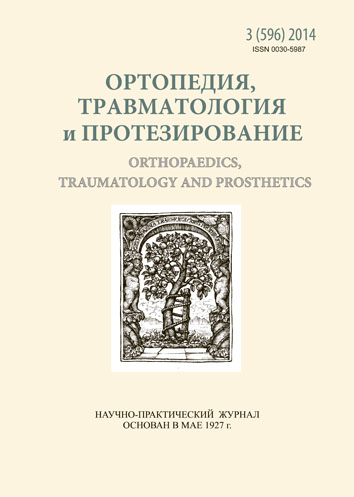Justification and analysis of geometric parameters of statographic data for evaluation the musculoskeletal system of human
DOI:
https://doi.org/10.15674/0030-59872014362-67Keywords:
statograf, musculoskeletal system, statogrammaAbstract
After statographic examinations of patients with different pathologies of the musculoskeletal system it was noted that the spots of the projection of the common center of mass (CCM) are significantly differ in shape and location on the plane of footing. Objective: To justify an opportunity of using of statographic parameters to assess the locomotor system of human. Methods: There were examined 15 patients with osteochondrosis of the lumbar spine, 15 with bilateral coxarthrosis stage III–IV, and 15 volunteers (control group). We estimated spot area of the CCMs under doubly and singly standing, total statographic area, ratios of these areas, asymmetry of statographic parameters, angular asymmetry, and the angle of rotation of the body. Results: Several geometric and spectral characteristics of statographic data designed and substantiated statistically. The features of these parameters for each group of the patients as well as their differences between the groups were shown. An analysis of indicators of the projected CCM area at doubly-standing and with a predominant reliance on each lower limb revealed that in all types of standing analyzed mark is significantly lower in the control group. At the same time there were no significant differences between the groups in the total area of statographic data. It was found that coefficients of asymmetry of dispersions for geometrical parameters of statographic data have no statistically significant differences between the groups, and the slopes of the rotation of the body can be indicators for the assessment of the musculoskeletal system because they statistically significantly differ between the groups. Conclusions: There were identified some parameters that can be used for functional assessment of the musculoskeletal system of human. There were also substantiated an opportunity of using of statographic parameters for creation of initial diagnosis.
References
- Gurfinkel V. S. Regulation of human posture / V. S. Gurfinkel, J. M. Kotz, M. L. Shik. — Moscow: Nauka, 1965. — 256 р.
- Skvortsov D. V. Stabilometry — functional diagnostics equilibrium function, musculoskeletal system and sensory system // Functional diagnostics. — 2004. — № 3. — Р. 78–84.
- Norr M. E. Posture testing (posturography) in the diagnosis of peripheral vestibular pathology / M. E. Norr, G. Forrez // Arch. Otorhinolaryngol. — 1986. — Vol. 243. — P. 186–189.
- Congresses of the International Society of Posturography, renamed the International Society for Postural and Gait Research: 1971 Madrid, published in Agressologie. — 1972. — Vol. 13.
- Congresses of the International Society of Posturography, renamed the International Society for Postural and Gait Research: 1983 Houston, Vestibular and visual control on posture and locomotor equilibrium / M. Igarashi, F. O. Black (Eds). — Karger, Basel, 1985.
- Alekseeva O. Yu. Methods of analysis stabilograms in assessing the functional state of human / O. Yu. Alekseeva, M. Yu. Karpinski // Medicine and ... . — 2002. — № 1. — Р. 48–53.
- Byuyul A. SPSS. Art information processing. Analysis of statistical data and restore hidden patterns / Achim Byuyul, Peter Tsёfel; translation from German. — SPb, "DiaSoft", 2005. — 608 p.
- Pat. 58892A Ukraine. MAC A61V5 / 103. The method of indirect assessment of the functional state of the musculoskeletal system of human / Mіtelev D. A., Karpіnsky M. Yu., Radchenko V. O. et al.; applicant and patentee SI "Institute of Spine and Joint Pathology them Prof. M. I. Sytenko Academy of Medical Academy of Medical Sciences. " — № 2002119151; appl. 18.11.2002; published. 15.08.2003; Bull. № 8.
Downloads
How to Cite
Issue
Section
License
Copyright (c) 2014 Olexiy Tyazhelov, Mykhaylo Karpinsky, Olenа Karpinska, Stanislav Yaremin

This work is licensed under a Creative Commons Attribution 4.0 International License.
The authors retain the right of authorship of their manuscript and pass the journal the right of the first publication of this article, which automatically become available from the date of publication under the terms of Creative Commons Attribution License, which allows others to freely distribute the published manuscript with mandatory linking to authors of the original research and the first publication of this one in this journal.
Authors have the right to enter into a separate supplemental agreement on the additional non-exclusive distribution of manuscript in the form in which it was published by the journal (i.e. to put work in electronic storage of an institution or publish as a part of the book) while maintaining the reference to the first publication of the manuscript in this journal.
The editorial policy of the journal allows authors and encourages manuscript accommodation online (i.e. in storage of an institution or on the personal websites) as before submission of the manuscript to the editorial office, and during its editorial processing because it contributes to productive scientific discussion and positively affects the efficiency and dynamics of the published manuscript citation (see The Effect of Open Access).














